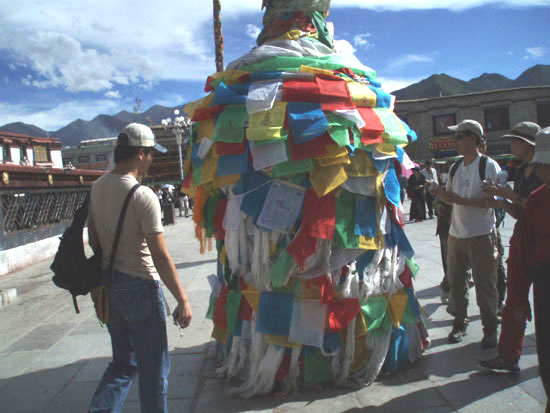Colours of Life: A Perspective from Tibet (Part 3)
by Jaina Mishra
G. CIGARETTE LIGHTERS
Although not in the realm of textiles – equally interesting are the metal and hide cigarette lighters that use flintstone and cotton wisps to create fire. Here is one I acquired for a friend, who I hope will be so frustrated at his lighting up effort, that he will give up smoking altogether! The pouch is filled with stones and bits of cotton.


H. FOOTWEAR
Tibetan shoes are decorated and a bit like soft snowboots. These are fast being replaced by sneakers and sandals but I did see enough of them on people walking around, to feel reassured thatthey are not extinct yet. Pictures of new boots from the net.


I. COLOURS OF AUSTERITY
The final and the most memorable colours came from the monks. The various shades of maroon are all rich and do not convey frugality at all, to me. But maroon was deliberately chosen for the dress code, because that was the cheapest dye in those parts.

Monks debating at Sera Monastery
filling the courtyard with colour and sound and philosophy!

Nuns at Barkhor – note their sun hats.
J. OTHER TEXTILES
There’s much more to the presence of textiles in Tibetan life, that I will just draw attention to through the pictures below – but will not elaborate upon ( mainly because I don’t know much about the textile aspect of these items).
Prayer flags:



Door/Window frill panels:



And brocade panels in monasteries:

CONCLUSION
Traditional
Tibetan textiles seem all the more interesting to me, since I read upon my
return, that "During the cultural revolution
(1966-68) the Chinese government banned the wearing of traditional costume by
ethnic minorities such as Tibetans." Makes me want to go right back and empty my bank account into all that is out
there, waiting to be preserved!
THE END OF THE JOURNEY
The irony
is that this was a journey in a land of
abundant colour, of happy blues and bursting yellows and full reds – yet, what
I saw, was the stark contrast, of the black and the white in that world, and in mine.